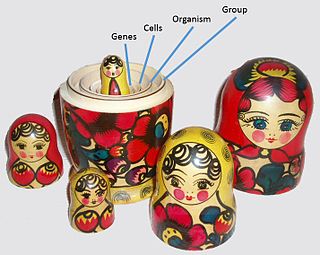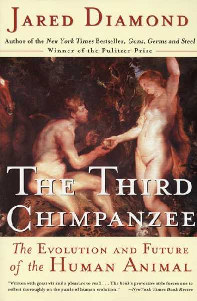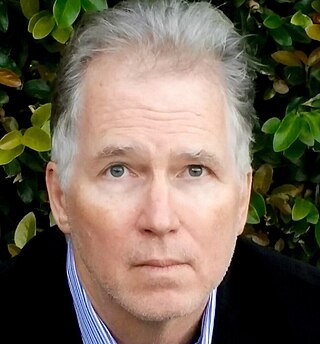John Philippe Rushton was a Canadian psychologist and author. He taught at the University of Western Ontario until the early 1990s, and became known to the general public during the 1980s and 1990s for research on race and intelligence, race and crime, and other purported racial correlations.

Sexual orientation is an enduring personal pattern of romantic attraction or sexual attraction to persons of the opposite sex or gender, the same sex or gender, or to both sexes or more than one gender. Patterns are generally categorized under heterosexuality, homosexuality, and bisexuality, while asexuality is sometimes identified as the fourth category.
Biological determinism, also known as genetic determinism, is the belief that human behaviour is directly controlled by an individual's genes or some component of their physiology, generally at the expense of the role of the environment, whether in embryonic development or in learning. Genetic reductionism is a similar concept, but it is distinct from genetic determinism in that the former refers to the level of understanding, while the latter refers to the supposedly causal role of genes. Biological determinism has been associated with movements in science and society including eugenics, scientific racism, and the debates around the heritability of IQ, the basis of sexual orientation, and sociobiology.

The relationship between biology and sexual orientation is a subject of on-going research. While scientists do not know the exact cause of sexual orientation, they theorize that it is caused by a complex interplay of genetic, hormonal, and environmental influences. However, evidence is weak for hypotheses that the post-natal social environment impacts sexual orientation, especially for males.

Guns, Germs, and Steel: The Fates of Human Societies is a 1997 transdisciplinary non-fiction book by the American author Jared Diamond. The book attempts to explain why Eurasian and North African civilizations have survived and conquered others, while arguing against the idea that Eurasian hegemony is due to any form of Eurasian intellectual, moral, or inherent genetic superiority. Diamond argues that the gaps in power and technology between human societies originate primarily in environmental differences, which are amplified by various positive feedback loops. When cultural or genetic differences have favored Eurasians, he asserts that these advantages occurred because of the influence of geography on societies and cultures and were not inherent in the Eurasian genomes.

A unit of selection is a biological entity within the hierarchy of biological organization that is subject to natural selection. There is debate among evolutionary biologists about the extent to which evolution has been shaped by selective pressures acting at these different levels.

Harald Meldal Eia is a Norwegian comedian, and sociologist. In recent years, Eia has also made TV-documentaries and written books.
Paul W. Ewald is an American evolutionary biologist, specializing in the evolutionary ecology of parasitism, evolutionary medicine, agonistic behavior, and pollination biology. He is the author of Evolution of Infectious Disease (1994) and Plague Time: The New Germ Theory of Disease (2002), and is currently director of the program in Evolutionary Medicine at the Biology Department of the University of Louisville.

The Third Chimpanzee: The Evolution and Future of the Human Animal is a 1991 book by academic and popular science author Jared Diamond, in which the author explores concepts relating to the animal origins of human behavior. The book follows a series of articles published by Diamond, a physiologist, examining the evidence and its interpretation in earlier treatments of the related species, including cultural characteristics or features often regarded as particularly unique to humans. The book was released in the United Kingdom in 1991 by Radius under the title The Rise and Fall of the Third Chimpanzee: How Our Animal Heritage Affects the Way We Live and in the United States in 1992 by HarperCollins under the title The Third Chimpanzee: The Evolution and Future of the Human Animal. In 2014, Diamond published an adapted version for young people with Seven Stories Press titled, The Third Chimpanzee for Young People.
Human male sexuality encompasses a wide variety of feelings and behaviors. Men's feelings of attraction may be caused by various physical and social traits of their potential partner. Men's sexual behavior can be affected by many factors, including evolved predispositions, individual personality, upbringing, and culture. While most men are heterosexual, there are minorities of homosexual men and varying degrees of bisexual men.

Ego-dystonic sexual orientation is a highly controversial mental health diagnosis that was included in the American Psychiatric Association's Diagnostic and Statistical Manual of Mental Disorders (DSM) from 1980 to 1987 and in the World Health Organization's (WHO) International Classification of Diseases (ICD) from 1990 to 2019. Individuals could be diagnosed with ego-dystonic sexual orientation if their sexual orientation or attractions were at odds with their idealized self-image, causing anxiety and a desire to change their orientation or become more comfortable with it. It describes not innate sexual orientation itself, but a conflict between the sexual orientation a person wishes to have and their actual sexual orientation.
Henry Cosad Harpending was an American anthropologist, population geneticist, and writer. He was a distinguished professor at the University of Utah, and formerly taught at Penn State and the University of New Mexico. He was a member of the National Academy of Sciences. He is known for the book The 10,000 Year Explosion, which he co-authored with Gregory Cochran.

Evolution of Infectious Disease is a 1993 book by the evolutionary biologist Paul W. Ewald. In this book, Ewald contests the traditional view that parasites should evolve toward benign coexistence with their hosts. He draws on various studies that contradict this dogma and asserts his theory based on fundamental evolutionary principles. This book provides one of the first in-depth presentations of insights from evolutionary biology on various fields in health science, including epidemiology and medicine.

The relationship between the environment and sexual orientation is a subject of research. In the study of sexual orientation, some researchers distinguish environmental influences from hormonal influences, while other researchers include biological influences such as prenatal hormones as part of environmental influences.

The 10,000 Year Explosion: How Civilization Accelerated Human Evolution is a 2009 book by anthropologists Gregory Cochran and Henry Harpending. Starting with their own take on the conventional wisdom that the evolutionary process stopped when modern humans appeared, the authors explain the genetic basis of their view that human evolution is accelerating, illustrating it with some examples.
Advances in knowledge about Tay–Sachs disease have stimulated debate about the proper scope of genetic testing, and the accuracy of characterizing diseases as specific to one ethnicity. Jewish communities have been in the forefront of genetic screening and counseling for this disease.
The Journal of Biosocial Science is a bimonthly peer-reviewed scientific journal covering the intersection of biology and sociology. It was the continuation of The Eugenics Review, published by the Galton Institute from 1909 till 1968. It obtained its current name in 1969, with volume numbering re-starting at 1, and switched publishers to Cambridge University Press. The editor-in-chief is Dr Alejandra Núñez-de la Mora.

The Human Biodiversity Institute also known by its acronym HBI is a private think tank linked to a far-right group of scientists, academics, and others associated with race and neo-eugenics theories often deemed pseudoscientific. Founded by Steve Sailer in the late 90s, the theories were given the euphemism human biodiversity. Ideas that originated in the group, presently believed to be dormant, have since entered general alt-right discourse.
Plague Time: The New Germ Theory of Disease is a non-fiction book by evolutionary biologist Paul W. Ewald. It argues that the role of pathogens has been overlooked in medicine, as a primary cause of many chronic diseases. It is his second book, following Evolution of Infectious Disease in 1994.
Ashkenazi Jewish intelligence, often referred to as "Jewish genius", is a subject that explores the perception that Ashkenazi Jews tend to have a higher intelligence than all other ethnic groups and excel disproportionately in many fields and has been an occasional subject of scientific controversy.







